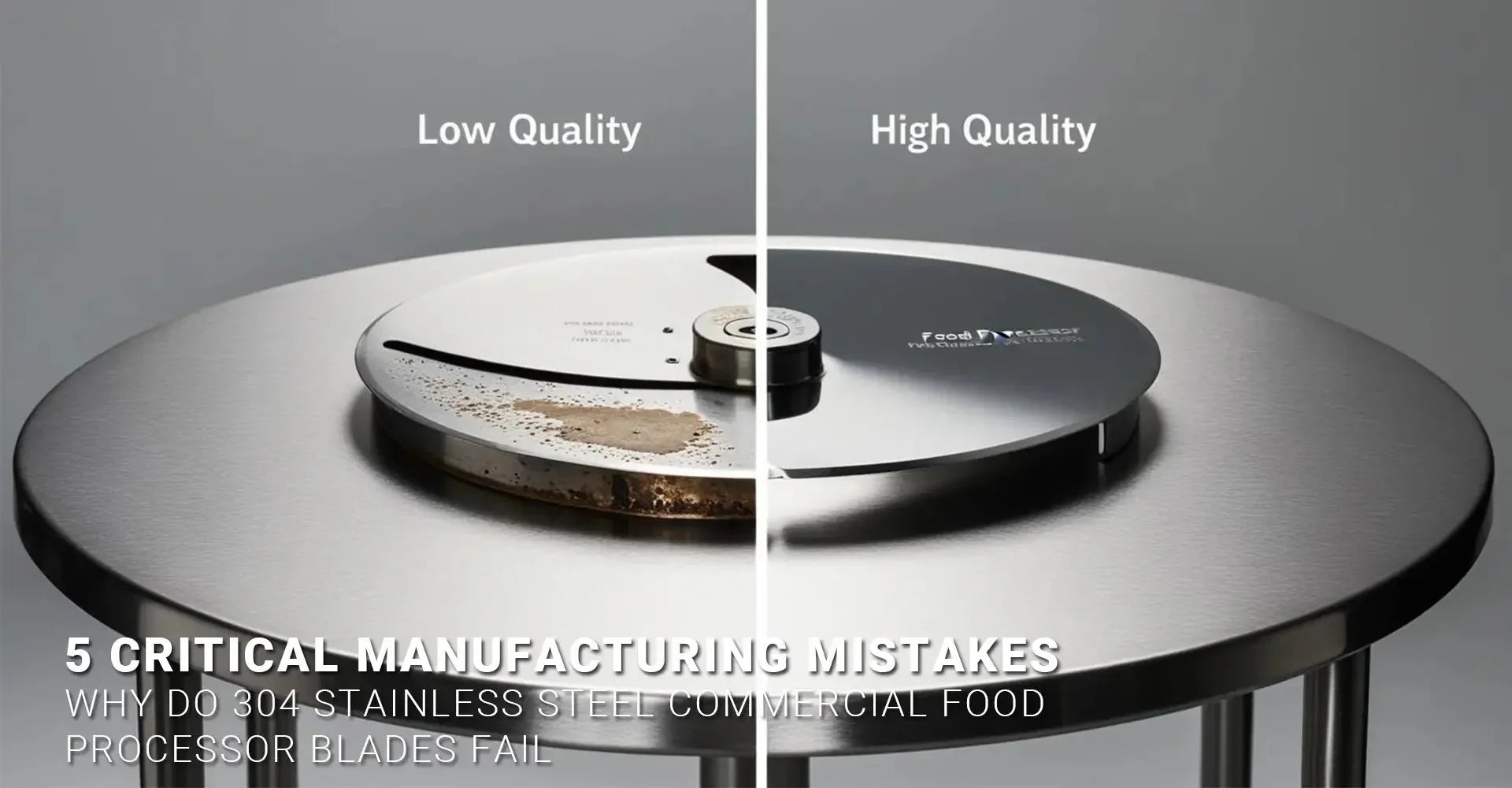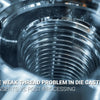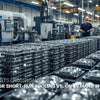Why Do 304 Stainless Steel Commercial Food Processor Blades Fail Prematurely? 5 Critical Manufacturing Mistakes Revealed

Why Do 304 Stainless Steel Commercial Food Processor Blades Fail Prematurely? 5 Critical Manufacturing Mistakes Revealed

The Hidden Costs of Poor Blade Quality
When it comes to commercial kitchen equipment, the quality of 304 stainless steel commercial food processor blades can make or break your operation's efficiency. Despite being a popular choice for food-grade applications, many manufacturers and buyers are unaware of the common pitfalls that lead to premature blade failure, increased maintenance costs, and even food safety risks.
What You Need to Know Right Now
The five most critical mistakes in stainless steel blade manufacturing include improper surface finishing, inadequate corrosion resistance in high-salt environments, substandard heat treatment processes, neglecting proper maintenance protocols, and overlooking industry certifications. Understanding these issues can save commercial kitchens thousands of dollars in equipment replacement costs while ensuring food safety compliance.
Before diving into the details, it's important to understand that not all 304 stainless steel is created equal. The manufacturing processes used to create these blades significantly impact their performance, longevity, and safety in commercial food processing environments. Let's examine the most common mistakes that lead to premature blade failure and how to avoid them.
Table of Contents
- Is "304 Stainless Steel" Always a Food-Safe Material?
- Does Corrosion Resistance Guarantee Long-Term Performance?
- How Does Heat Treatment Affect Blade Performance?
- What Regular Maintenance Do "Stainless" Blades Actually Require?
- Conclusion
Is "304 Stainless Steel" Always a Food-Safe Material?
Many food service professionals assume that any blade labeled as 304 stainless steel automatically meets food safety standards. However, this misconception overlooks a critical factor: surface finish quality.
The truth is that even genuine 304 stainless steel can harbor dangerous bacteria if the surface finish is improperly executed. Surfaces with roughness values (Ra) exceeding 0.8μm create microscopic crevices where bacteria can hide and multiply, even after standard cleaning procedures. These invisible danger zones persist despite the inherent antimicrobial properties of 304's chromium content.

When examining food-safe surface finishes for stainless steel, industry experts recommend electropolished finishes with Ra values of 0.5μm or less for commercial food processing applications. This specification is particularly important for high-volume operations where blades contact various food substances throughout the day.
FDA 21 CFR and EU 10/2011 regulations establish clear guidelines for food-contact surfaces, including specific requirements for surface finish quality. Many low-cost blade suppliers fail to meet these standards, creating both safety and legal liability issues for commercial kitchens. When sourcing blades for your kitchen appliances, always request certification documentation that specifically addresses surface finish specifications.
Does Corrosion Resistance Guarantee Long-Term Performance?
Another widespread misconception is that the corrosion resistance of 304 stainless steel ensures long-term durability in all kitchen environments. This assumption fails to account for the specific challenges of commercial food processing.
While 304 stainless steel offers good general corrosion resistance, it remains vulnerable to pitting corrosion in high-chloride environments—a common scenario in seafood processing or kitchens in coastal areas. This overlooked factor is one of the most common mistakes in stainless steel blade manufacturing decisions.

When comparing 304 vs 420HC steel for food-grade blades, each material offers distinct advantages. For environments with high salt content, 316L stainless steel (with 2-3% molybdenum) provides superior pitting resistance compared to standard 304. However, 420HC offers better edge retention with HRC values of 58-60, making it preferable for meat processing applications, while 304 excels in vegetable processing where edge wear is less severe.
To ensure your blades will withstand your specific operating environment, insist on comprehensive salt spray test standards for commercial cutlery. Quality manufacturers should provide test results from ASTM B117 protocols, with minimum exposures of 96 hours for basic applications and 240+ hours for high-risk environments. These tests simulate years of real-world exposure in accelerated conditions, revealing potential weaknesses before they become costly failures.
How Does Heat Treatment Affect Blade Performance?
Heat treatment is perhaps the most technically complex aspect of blade manufacturing, yet it's often the most overlooked factor when purchasing commercial food processor blades. This oversight leads to significant performance issues and shortened blade lifespan.
The hardness of stainless steel blades, measured on the Rockwell C scale (HRC), directly impacts edge retention and overall durability. Poorly executed heat treatment processes create blades with inconsistent hardness, often below the recommended HRC 55-58 range for commercial applications.

Understanding the heat treatment pitfalls for stainless steel blades can help you make more informed purchasing decisions. Improper annealing or quenching processes can leave internal stresses in the blade material, leading to warping or premature fracture during use. Additionally, incorrect tempering temperatures can compromise the balance between hardness and toughness, resulting in brittle blades that chip easily during heavy-duty commercial food processing.
For optimal performance, commercial food processor blades should undergo precision heat treatment with rigorous quality control measures. This process should include proper solution annealing, controlled cooling, and precise tempering to achieve the ideal combination of hardness, toughness, and corrosion resistance. When sourcing blades, request documentation of heat treatment parameters and hardness testing results to ensure consistent quality and performance.
What Regular Maintenance Do "Stainless" Blades Actually Require?
Despite the name "stainless," 304 stainless steel blades require regular maintenance to maintain their integrity and performance. This maintenance myth is especially problematic in busy commercial kitchens where time pressures can lead to neglected blade care.
Many commercial kitchen staff don't realize that acidic food residues—particularly from tomatoes, citrus fruits, and vinegar-based ingredients—can compromise the passive chromium oxide layer that gives stainless steel its corrosion resistance. Similarly, abrasive cleaning methods can scratch the surface and create potential corrosion sites.

To maximize corrosion resistance for kitchen appliance blades, implement these maintenance best practices:
- Clean blades promptly after use, especially after processing acidic foods
- Use non-abrasive cleaning tools and food-safe detergents
- Rinse thoroughly with clean water to remove all chemical residues
- Dry completely before storage to prevent moisture-related corrosion
- Periodically inspect for signs of pitting or discoloration
- Consider professional repassivation for heavily used blades every 6-12 months
Following these guidelines can significantly extend blade life and maintain food safety standards. Furthermore, proper maintenance helps preserve the surface finish quality, preventing the microbial contamination risks discussed earlier.
Conclusion
The cost of poor material selection in kitchen equipment extends far beyond the immediate expense of replacement blades. Production downtime, compromised food quality, and potential safety hazards all contribute to the true cost of cutting corners on blade quality.
By understanding the five critical manufacturing mistakes we've discussed—improper surface finishing, inadequate corrosion resistance, substandard heat treatment, neglecting maintenance requirements, and overlooking certifications—commercial kitchen managers can make more informed purchasing decisions and implement better maintenance protocols.
When evaluating potential suppliers for your commercial food processor blades, use this checklist:
- Request surface finish specifications (aim for Ra ≤0.5μm)
- Verify appropriate alloy selection for your specific food processing needs
- Ask for heat treatment documentation and hardness testing results
- Confirm compliance with relevant food safety regulations
- Establish a clear maintenance protocol based on manufacturer recommendations
One striking case study demonstrates the impact of these factors: A commercial food processing facility reduced blade replacements by 70% after switching to properly manufactured 304 stainless steel blades with electropolished finishes and implementing improved HRC testing protocols. The initial investment in higher-quality blades paid for itself within three months through reduced downtime and replacement costs.
External Resources
[304 stainless steel commercial food processor blades][^1]
[Corrosion resistance for kitchen appliance blades][^2]
---
[^1]: Explore the advantages of 304 stainless steel blades for food processors, including durability and corrosion resistance.
[^2]: Learn about the importance of corrosion resistance in kitchen appliance blades to ensure longevity and safety.
-
Posted in
Kitchen appliances Manufacturing





